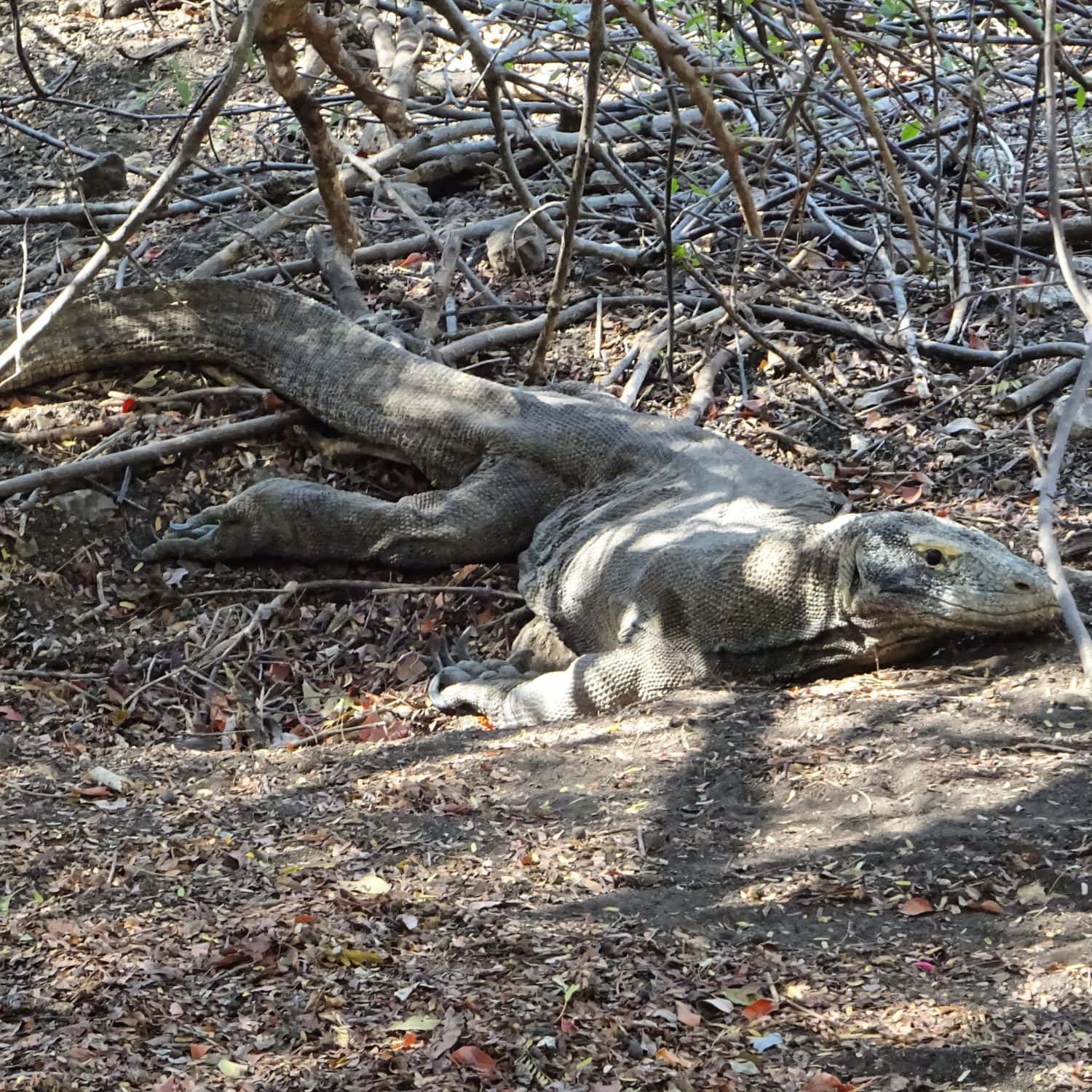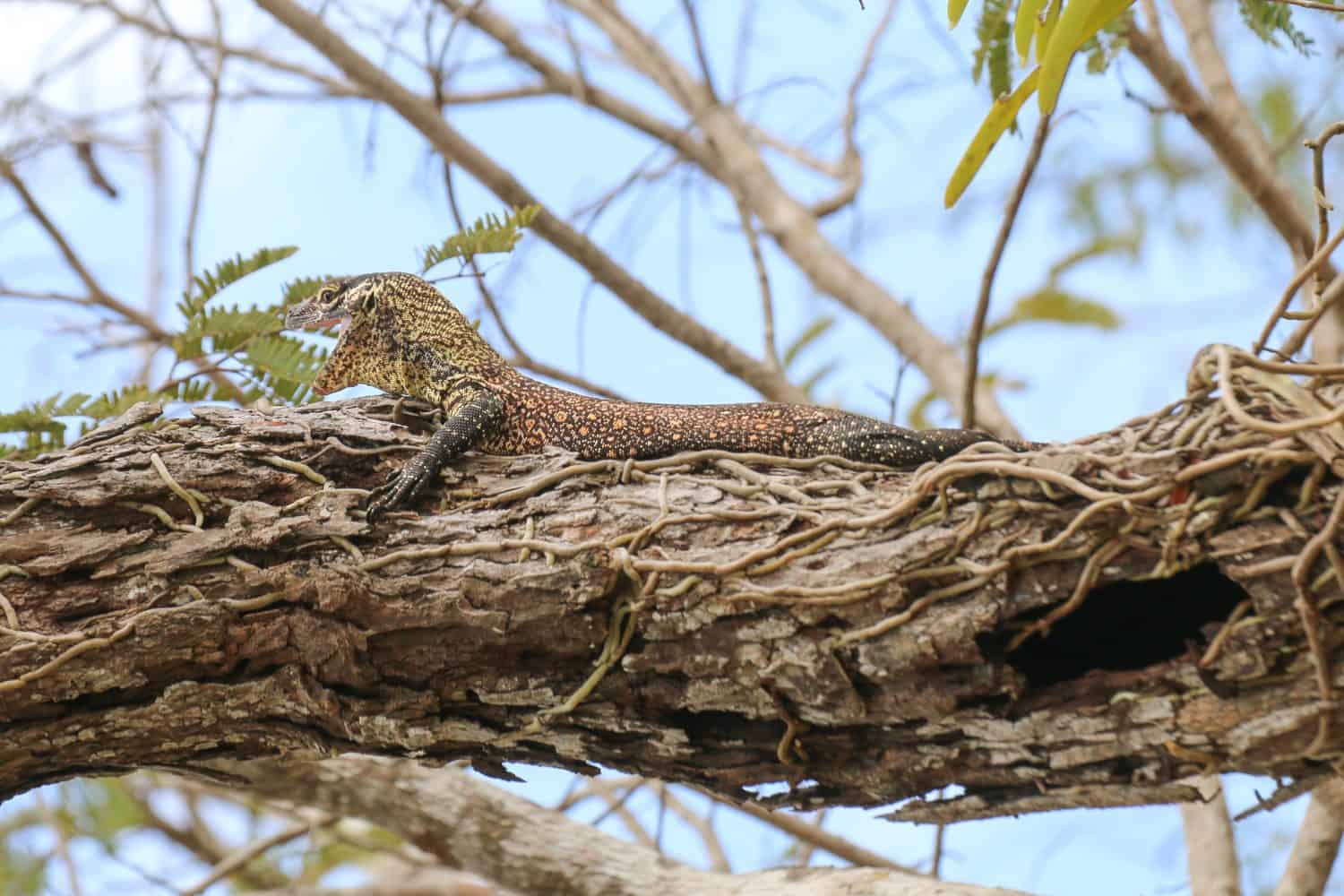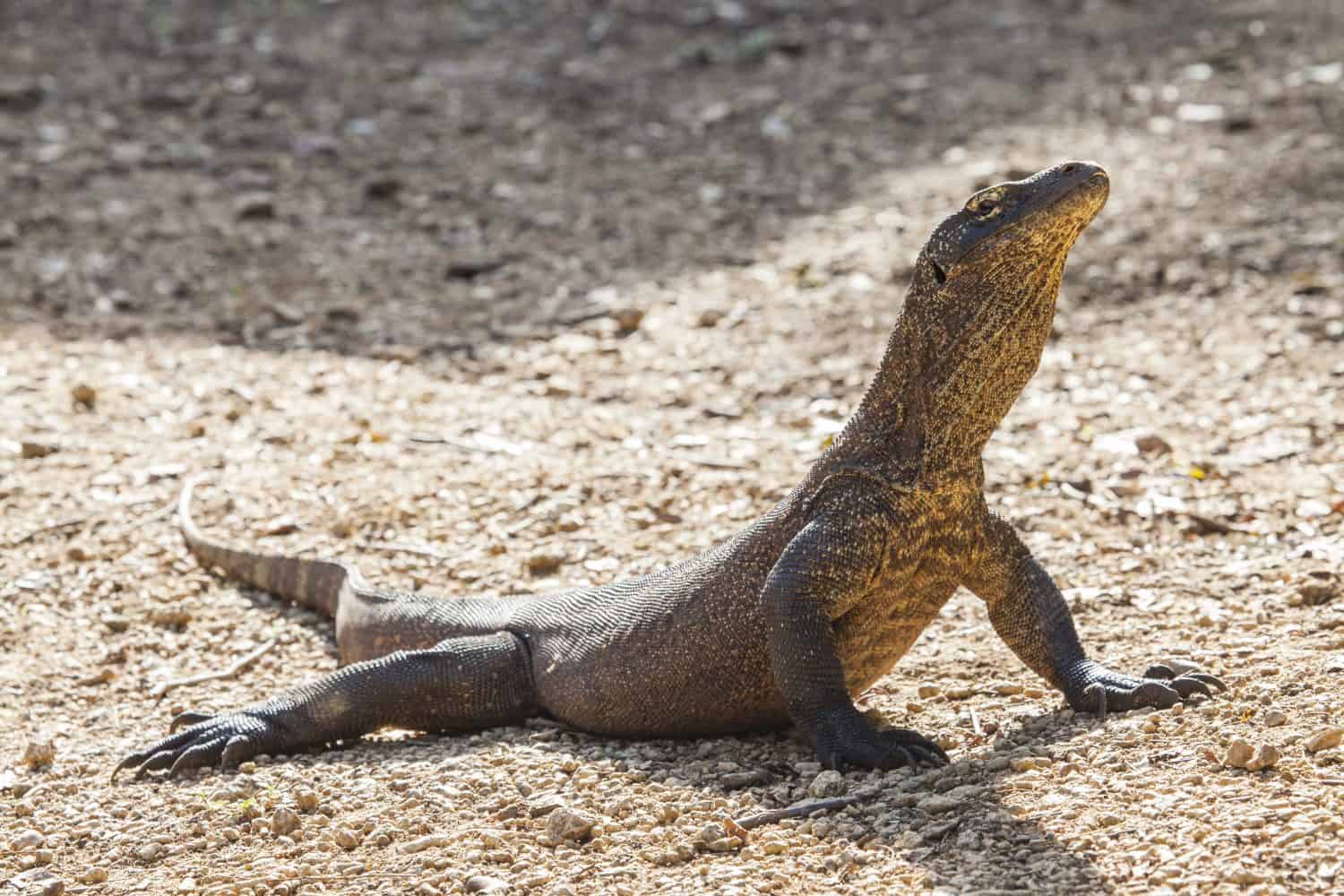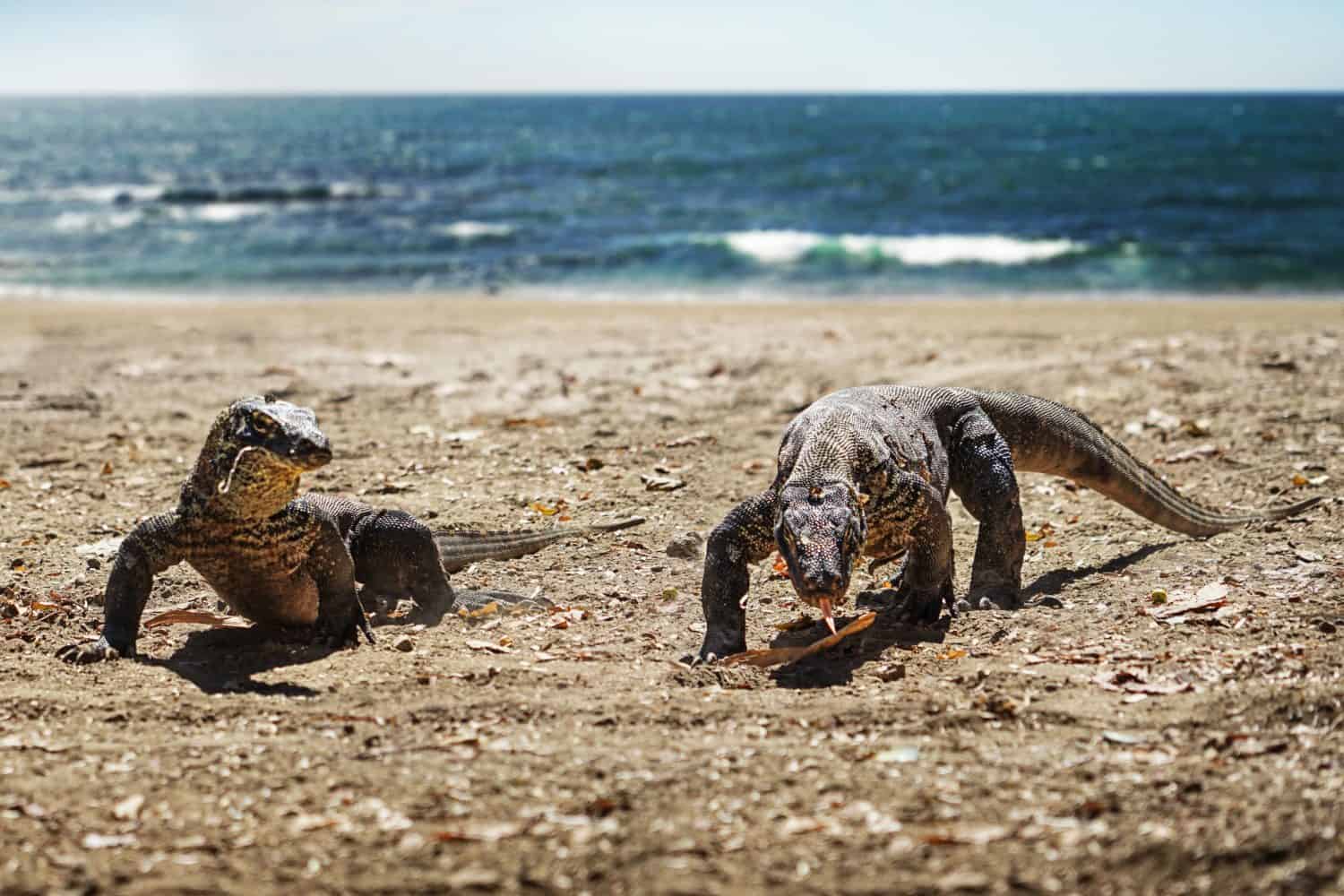The Komodo dragon (Varanus komodoensis) is an endangered species endemic to just four small islands of Indonesia: its namesake, Komodo, as well as Rinca, Flores, and Gili Motang. It is the world’s largest and heaviest living lizard, with adult males capable of growing to over 3 m (10 ft) long and weighing nearly 90 kg (200 lbs). However, these apex predators start life small and are vulnerable to predation – including by adults of their own species! Read on for six pictures and six facts about baby Komodo dragons.
1. Komodo Dragons Lay Clutches of Eggs in Nests

This female Komodo dragon is guarding her nest from predators.
©Sean Greenwood/Shutterstock.com
In the wild, Komodo dragon breeding season is from July through August, with eggs laid about a month later. Alternately, female Komodo dragons are also capable of parthenogenesis — that is, they can sometimes self-fertilize eggs without a male. (Scientists hypothesize this may be an evolutionary adaptation that allows single females to colonize new territory, such as a previously unoccupied island.)
Females lay an average of 20 – 30 eggs (up to 38) about the size of grapefruits with leathery shells. The mother may either repurpose an abandoned megapode (mound-builder bird) nest or dig her own hillside or ground nest. She also creates multiple decoy nests to deter predation. The mother guards the nest for a few months, usually until the rainy season starts in December, but not for the entire incubation period.
Females may not nest every year, taking breaks in between to recuperate their energy.
2. Komodo Dragon Eggs Hatch After About 7 – 9 Months

Komodo dragon hatchlings are highly vulnerable to predation.
©Tommy Johansson/Shutterstock.com
The baby dragons finally hatch a few months after the mother leaves the nest, usually in March or April. They use a special egg tooth to tear open their egg and then tunnel up out of their nest. Hatchlings average 40 cm (16 in) long and weigh about 100 g (3.5 oz). Their emergence is timed with the peak of the summer rainy season, providing the hatchlings with abundant plant growth for cover and insects for food. Nestmates may stay together in small groups even after hatching for several months.
3. Baby Komodo Dragons Are More Colorful Than Older Dragons

Baby Komodo dragons have intricately patterned skin.
©Daniel Karfik/Shutterstock.com
Unlike adult Komodo dragons, which sport mostly uniform skin color in various shades of dull earth tones such as clay, tan, or green, hatchlings are born speckled with vibrant yellow and orange markings. This mottling is presumed to serve as protective camouflage while the young dragons spend most of their early life in the trees.
4. Young Komodo Dragons Climb Trees To Avoid Predators — Including Adult Komodo Dragons

Only young Komodo dragons are small and agile enough to climb high up into the trees.
©Manoj Sekar/Shutterstock.com
Baby Komodo dragons are vulnerable to predators, so they take refuge in a nearby tree as soon as they hatch. Interestingly, one of their primary predators is cannibalistic adults! Since the adults are too large and heavy to climb trees, the more agile young dragons can avoid becoming a snack by staying high up in the tree canopy until they are big enough to fend for themselves and adopt a more terrestrial lifestyle.
5. Little Dragons Hunt Small Prey

Komodo dragons use their forked tongues to pick up the scent of prey.
©Heiko Jetzkowitz/Shutterstock.com
While adult Komodo dragons can take down large prey such as wild boars and deer, baby Komodo dragons mainly feed on the small insects and lizards found in their trees. As they grow, they can both spend more time hunting on the ground and move on to progressively larger prey, including snakes, birds, and rodents.
6. Young Dragons Have Weird Tricks To Avoid Being Cannibalized

Young Komodo dragons transition from arboreal to terrestrial life as they grow.
©Shahar Shabtai/Shutterstock.com
Besides hanging out in the trees, young Komodo dragons also roll around in the feces of prey animals or the rejected parts of kills (e.g., fur, intestines) to mask their scent from hungry adults. Juveniles also perform odd dances the Smithsonian National Zoo calls “rituals of appeasement.” These involve “pacing around a feeding circle in a stately ritualized walk [as] the tail is stuck straight out, and they throw their body from side to side with exaggerated convulsions.”
7. Komodo Dragons Mature Slowly and Have Long Lifespans

Komodo dragons are well adapted to island life, including being excellent swimmers.
©Eduardo Teixeira de Sousa/Shutterstock.com
While some sources report that captive dragons can reach sexual maturity as early as 5 – 7 years, full sexual maturity is more commonly cited as 8 – 10 years. Estimates of their lifespan in the wild also vary from 30-60 years. A 2012 study suggests that this wide range may be from males living much longer lives on average than females. This, in turn, is likely due to the enormous energy costs associated with egg laying and nesting.
Conclusion
Komodo dragons lay clutches of eggs in a mound or underground nests, which the mother guards for the first few months. The baby dragons hatch after an incubation period of about 7 – 9 months. Hatchlings have colorful speckled skin that likely provides camouflage as they both shelter and feed in the tree canopy. Adult dragons are one of the primary predators of young dragons; juveniles avoid cannibalization by climbing trees, masking their scent, and performing ritual appeasements at feeding circles. Young dragons eat small prey, such as insects and small lizards, and move on to progressively larger prey as they grow and spend more time on the ground. Komodo dragons may take anywhere from 5-10 years to mature and live anywhere from 30 – 60 years, with males growing larger and living longer on average.
The photo featured at the top of this post is © Allan y/Shutterstock.com
Thank you for reading! Have some feedback for us? Contact the AZ Animals editorial team.






